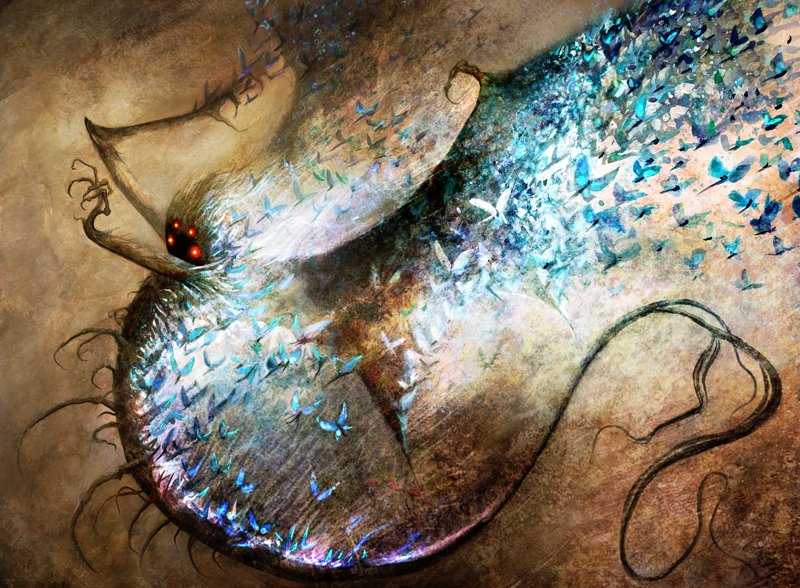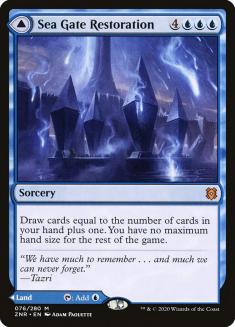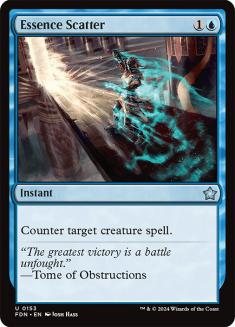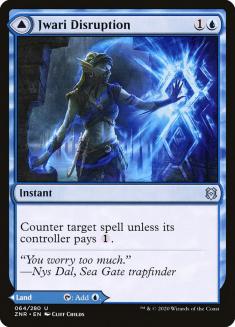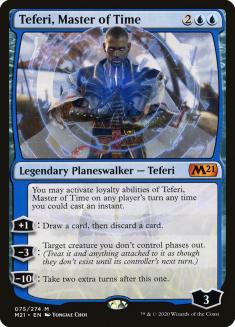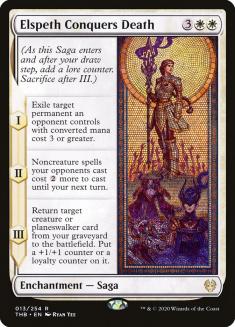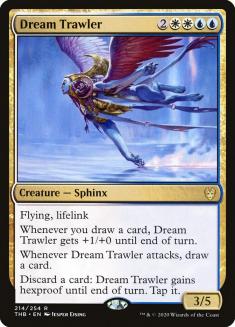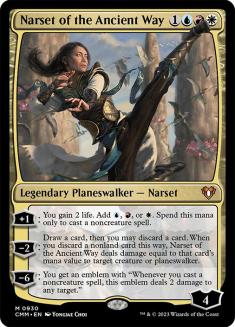With each passing weekend, control asserts its dominance in Zendikar Rising Standard. While Gruul Adventures is regarded as the best deck, most control decks have a high win percentage against it while also competing with the other decks in the format. Dimir Rogues and Temur Ramp have often presented a challenge, but even against those powerful foes, my favorite archetypes put up a decent fight.
The aspect of the metagame that impresses me the most is the good matchup against Gruul Adventures that all three decks I’m posting here has. Out of the three, Dimir Control still performs the best across the board. In the SCG Tour Online $5K Kaldheim Championship Qualifier that finished last weekend, Dimir Control narrowly missed hoisting the trophy. This version is a bit more draw-go than mine, with more duds against the aggressive decks of the format, and still managed to cruise to a high finish.
1. Dimir Control
Creatures (2)
Planeswalkers (2)
Lands (20)
Spells (36)

Extinction Event, Shadows’ Verdict, Heartless Act, and Murderous Rider provide black-based control with the easier path to victory against a linear field. Gruul Adventures is not doing anything clever, with easy must-kills in the early-game and a difficulty coming back from a cleared battlefield in the late-game. This is where Dimir Control, like the version above, performs the best.
This deck lives off the one-for-one, eventually extracting value out of the win conditions and a lovely Sea Gate Restoration. One of these days soon, I will be able to write an article that does not involve a soap box and this expensive sorcery, but today is not the day. Sea Gate Restoration, for all the criticism it has received, is still one of the most powerful of its cycle. As Kanister declared it a “seven-mana Opt” around a month ago, I took it upon myself to restore and promote Sea Gate Restoration for what it really is. This card draws typically three to four when needed abruptly, but it has often played more of a combo role for me. The preparation to deploy it, the turn after a permanent has been dealt with, can lead to a thirteen-card hand upon resolution with no discard in sight. This is not the sign of a weak spell and the Magic world is slowly coming around to it.
My version of Dimir Control still differs from Maradei’s; however, his list did inspire me to make a few changes. He has an uncomfortably low amount of early-creature interaction, which will cause losses in easy matchups against the linear aggro decks. Essence Scatter is great when you’re on the play, but a disastrous liability against the best deck when on the draw. Having only three copies of Heartless Act to stop a one- and two-drop is too large of a gamble when the best removal spells are at your fingertips. This is what I suggest moving forward.
Creatures (2)
Planeswalkers (5)
Lands (22)
Spells (31)
- 1 Negate
- 1 Drown in the Loch
- 2 Cling to Dust
- 4 Neutralize
- 4 Shark Typhoon
- 4 Extinction Event
- 4 Heartless Act
- 2 Eliminate
- 4 Frantic Inventory
- 2 Sea Gate Restoration
- 2 Jwari Disruption
- 1 Hagra Mauling
Sideboard

After looking at Maradei’s and other lists from successful MTG Arena runs, a few changes became obvious to me. As much as I love Jace, Mirror Mage, it does not fit in Dimir Control when the format is this aggressive. Most card advantage is rooted in Frantic Inventory, a spell that’s criminally underplayed in most formats. I slowly see decks incorporating it because of how efficient it is. The early cost to cycle one away is two mana, where the copies that follow provide a fantastic advantage. There’s no excuse to shy away from Frantic Inventory at this point unless you’re piloting a ship with 80 cards in it. In those situations, Omen of the Sea is the captain and that’s acceptable.
The other modifications made centered around adding more DFCs, especially those that interact in the early-game. Jwari Disruption is the most powerful option, opening the door to additional blue disruption throughout the game. Censor is the closest comparison, a Force Spike that can be pitched when irrelevant or when additional land is needed. Dimir Control makes full use of its mana, as the losses to flooding have become much less frequent. There are too many ways to efficiently move through the library these days, making that an issue in the past for control. Aggressive and midrange decks still can feel the pain of a handful of late-game lands, which is one of the main reasons why I have always sought out the Island as my champion.
The changes have boosted my play against the field, with a small sacrifice to some mana stumbling. The DFCs are great in the manabase; however, they all enter the battlefield tapped outside of Sea Gate Restoration. This is the sacrifice we make to have access to additional spells when mana is not needed, and I am fine with that. In the world of special land upside, I was reluctant to add Crawling Barrens. That apprehension quickly faded after getting in a few games with it, but I did drop it down to one copy. The colorless land did impact more games than I wanted it to, since we need double black and double blue on Turn 3 in some cases. Overall, the mana base of my Dimir Control deck has improved since the modifications.
Dimir Control is the strongest of my control creations still. This is on the back of black-based removal, but also thanks in part to the permanents I always include in any control list. I will always play Ugin, the Spirit Dragon; Teferi, Master of Time; and Shark Typhoon if there are Islands involved. Too many lists are still stubbornly opting out of Ugin and it is costing them games. Although it’s not devastating against control decks, it wipes out the rest of the competition on its own. The interaction prior to a resolved eight-mana planeswalker can make it a clean win, but even when on the ropes, the same result occurs. It’s the best reset button and gameplan against the decks in this format, most of which have a large battlefield presence.
Not much needs to be said about Teferi, Master of Time and Shark Typhoon, except they need to be included. In a flash deck, you want to have four copies of Shark Typhoon. In more tap-out control decks, three is the acceptable amount. When playing against unknown opponents, it’s best to have the most versatile spells in the maindeck, like this one. Some matchups require one or two to get sideboarded out, but most decks do not want to see them resolve into multiples.
Teferi, Master of Time is a sorcery-speed permanent that does not provide a consistent level of disruption for creatures on the battlefield, nor does it give traditional card advantage. Even with these negatives, it’s still one of the better tap-outs the turn after disruption clears the battlefield. It’s important that control decks have this dynamic, which pulls additional threats into an Extinction Event lest the opponent suffer the planeswalker consequences for producing too little pressure. There are other decks where Teferi, Master of Time plays a stronger role in.
2. Azorius Control
Creatures (3)
Planeswalkers (3)
Lands (20)
Spells (34)

Although Azorius Control is not my first choice in this format, it has some potential. This control deck plays completely different from Dimir Control, often forced to tap out every turn to disrupt the opponent. This is largely due to the lack of powerful removal at instant speed, with Azorius Control being forced to lean on Glass Casket early and Shatter the Sky late. Due to the lack of strong removal outside of those two spells, some concessions must be made.
Essence Scatter is needed in this deck. The more early-game threats that resolve, the more dependence is put on Shatter the Sky. The best sweeper in Zendikar Rising Standard is up for the challenge; however, it’s not always drawn in a timely fashion. This is where Essence Scatter and Jwari Disruption can save your life, preventing the threats from existing in the first place. As mentioned before, this plan of attack is much stronger on the play.
Gruul Adventures can run away with the game even then, summoning an Edgewall Innkeeper on Turn 1, creating an uphill battle from the start. Dimir Control has seven ways to remove it from the battlefield before it does any damage, while Azorius Control has four. There’s simply no supplemental removal that works well enough against other threats, hence the reason you see Swift Response in the sideboard.
Even with these early-game deficits, Azorius Control is still a powerful deck. The late-game power it has makes the early-game struggles well worth it.
Elspeth Conquers Death and Dream Trawler destroy the best decks in the format outside of Dimir Rogues. These late-game bombs are game-ending, which is why most of Azorius Control focuses on surviving to that point. We again utilize Frantic Inventory as the card advantage engine, but also have a few exclusives that come with white. The Birth of Meletis is still one of the best Turn 2 plays in most competitive formats when the opponent has one- and two-drops. It’s showcased here, giving the actual land count a boost and making it easier to play a few more spells in the list.
The more exciting late-game engine in Azorius Control is Legion Angel, which has blown me away. Who would have thought a giant Squadron Hawk would be playable again? This card is built for the control user, allowing us to sacrifice a few sideboard slots in an archetype that does not need them as much, while providing a steady flow of Angels starting on Turn 4.
This is the tap-out strategy that I love to play but had to shelve while Dimir Rogues was ruling the format. With Gruul Adventures and Rakdos Midrange annihilating that silly Mill deck, we are free to look at the main phase decks once again. This leads us to the most fun main-phase deck in my control trio.
3. Jeskai Control (Yorion)
Creatures (3)
Planeswalkers (5)
Lands (29)
Spells (43)

I wrote about Jeskai Control (Yorion) a couple of weeks ago and I am still feeling good about Turn 4 Dream Trawler. I made fewer changes to Jeskai Control, as I believe it is in a great place for the current metagame as is. I altered the manabase, adding a few more DFCs and slightly adjusting the color-producing numbers. The other differences look minor on paper but have resulted in smoother gameplay against all decks in the metagame.
Jeskai Control is a traditional tap-out control deck at its core, providing users with the Azorius Control foundation while sprinkling a few instant-speed removal spells from red. This is the beauty of playing Yorion, Sky Nomad: allowing players to get all their favorite spells involved, which is not always possible in a 60-card deck. This paved the way for the return of Narset of the Ancient Way, another powerful planeswalker that does not see enough play. The other elements of Jeskai Control provide the same disruption, card advantage, and win conditions you would expect, with the surprise combo seamlessly woven in.
Transmogrify is the wild card that makes Jeskai Control unique. This is where the Turn 4 Dream Trawler is made possible, but it’s much more than that. Making Dream Trawler effectively cost four mana is a game-changer late. Azorius Control was always forced to tap out for a Dream Trawler, which was typically a safe play. Now it is even safer to bring out, with more mana open to provide protection on the side.
To maximize the chances of Transmogrify working, I added another Omen of the Sun, giving Jeskai Control twelve ways to produce a token on Turn 3. This, combined with fixing the sideboard to address the current top of the field, has made Jeskai Control a close third in deck choices for me.
Although Dimir Control has my heart now, these other two decks are courting me every day. Each can beat the best decks, with slight struggles with Dimir Rogues, making them dynamite choices in upcoming competitive play.

